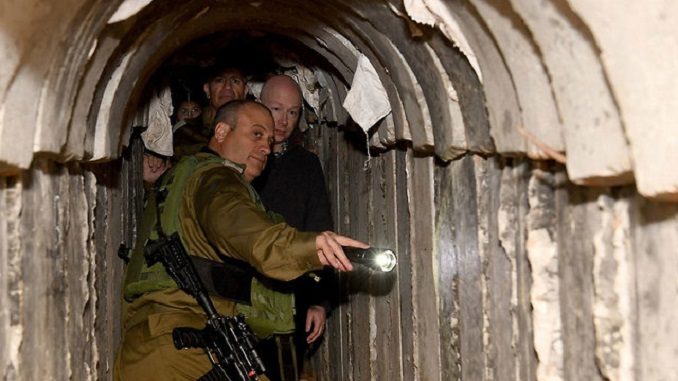
U.S. President Donald Trump’s special Middle East envoy Jason Greenblatt, who recently visited Israel’s communities on the Gaza perimeter and toured the terror tunnel the IDF exploded, claimed Sunday that Iran provided $100 million annually to Hamas, Jewish Press reports.
“Imagine what the people of Gaza could do with the $100 million Iran gives Hamas annually that Hamas uses for weapons and tunnels to attack Israel! Iran spends almost a billion dollars a year sponsoring terrorism in Lebanon, Israel and West Bank/Gaza. This blood money only increases violence and does nothing to help the Palestinian people he tweeted. The corrupt regime in Tehran squanders the resources of the Iranian people on military adventures throughout the region instead of investing at home and promoting peace abroad,” President Trump’s envoy added.
“Hamas must also permit the repatriation of Hadar Goldin’s remains and the release of Oron Shaul, as well as the release of Israeli civilians – Avraham Abera Mengistu, Hisham al-Sayed, and Juma Ibrahim Abu Ghanima.”
The latter three Israelis have not been heard from or seen since they crossed the border in 2014. The two IDF officers were killed in Hamas attacks that took place during what was were supposed to be “cease-fire” periods in the 2014 war with Hamas in Gaza. The bodies of both were taken by Hamas terrorists and have been held in Gaza since.
Greenblatt has several times taken to Twitter in the past week to criticize Gaza’s Hamas rulers for spending the funds they receive to build terrorist tunnels instead of allocating those funds to help the people of Gaza.
“Hamas literally undermines Gaza’s chance for success— now building a terror tunnel under a crossing to Israel that should be a conduit toward a better economy. A terror tunnel costs roughly $5.9 million to build ($ that belongs to the people of Gaza) plus roughly $30,000 a day in lost revenue when the crossing is closed as a result. Gaza needs options besides Hamas and its enablers. Time to stop pouring money into violence and hatred, and to start investing in a real future for Palestinians in Gaza,” he wrote last Monday.
A week ago Sunday, Greenblatt toured the Israel-Gaza border area, accompanied by the IDF’s Coordinator of Government Activities in the Territories (COGAT) Major General Yoav Mordechai. Greenblatt visited one of the recently discovered Hamas terror tunnels, which extends from Gaza into Israel, and received a comprehensive security briefing regarding the threats emanating from Gaza.
After visiting the Gaza perimeter and touring the tunnel, Greenblatt tweeted:
“Hamas wastes resources on tunnels & rockets to attack Israel, instead of helping the people of Gaza by getting the lights on, the water flowing & the economy growing. Hamas spews hateful rhetoric & foments a vicious cycle of violence. Gaza deserves better!” Greenblatt added.
The chorus of voices within Israel’s defense establishment cautioning that the deteriorating humanitarian situation in Gaza may lead to military confrontation—or to Israel having to assume civilian responsibilities over infrastructures in the strip to prevent utter collapse—has grown exponentially in the past year
The situation in Gaza, taken together with the buck of solving it being passed around, leaves Israel as the only capable player on the field. The Hamas-Fatah reconciliation process is mired deeply in a crisis that is slowly transforming into a freeze, and both sides appear to be digging in their heels.
IDF Chief of Staff Gadi Eisenkot said at the weekly Cabinet meeting Sunday that no actors sought war or another round of hostilities in Gaza, but there was growing concern over a conflagration happening nonetheless due to the circumstances in the strip—the precarious humanitarian situation and the crisis in Hamas-Fatah relations. Eisenkot’s statements came during a security overview he had provided the ministers as part of what has been called “deepening their knowledge base.”
The chief of staff added that efforts should be made to prevent a total humanitarian collapse in Gaza, but that humanitarian assistance—which the IDF supported—needed to be kept separate from a complete rehabilitation of Gaza, which should be conditioned on returning the bodies of IDF soldiers Oron Shaul and Hadar Goldin as well as the Israeli civilians held captive by Hamas.
The army chief further noted that the humanitarian crisis there has worsened with added intensity since Palestinian Authority President Mahmoud Abbas has begun implementing a policy of disengagement from Gaza. The crisis was especially grave, Eisenkot said, as it pertained to problems with water and power supplies. On the same topic, Prime Minister Benjamin Netanyahu commented that Israel would be “glad if international organizations and bodies assisted Gaza.”
The current reconciliation agreement, then, seems to be about to take its place among countless previous reconciliation processes whose sole existence was on documents produced by the two parties. Likewise, President Abbas has continued levying sanctions on Gaza, despite his decision to resume payments to Israel to restore the strip’s power levels to what they were before the sanctions were imposed.
Egypt, the broker of this latest reconciliation attempt, continues keeping the Rafah Border Crossing locked up tight, despite Hamas handing over responsibility for crossings to the Palestinian Authority. Very few people pass through the Erez Border Crossing, meanwhile, as the Kerem Shalom crossing for goods is seeing less and less traffic due to dwindling orders from Gaza in light of dire financial fortunes.
International aid groups, for their part, are carrying out a dwindling number of projects in Gaza. The United Nations’ agency for Palestinian refugees, which is feeding close to a million mouths in Gaza, faces a severe cut of its budget following a decision by President Trump and it remains unclear how it will prioritize its various project in the region, and to which degree the strip’s residents will be harmed by the cut.
